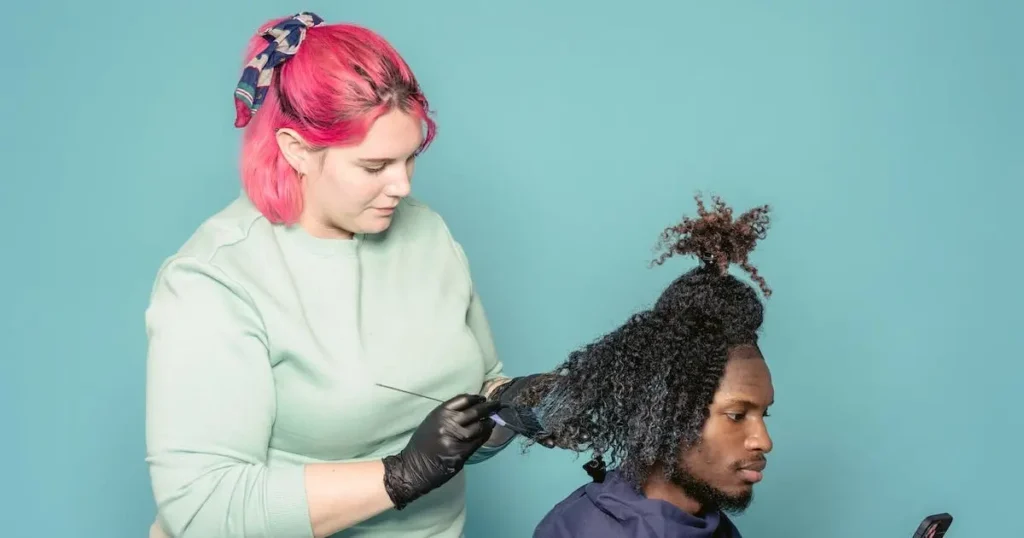Cutting curly hair properly can seem daunting for beginners. Unlike straight hair that falls evenly, curls spring up and bounce into different shapes making it difficult to control. However, learning some basic techniques and following a step-by-step process can set you up for success.
This comprehensive guide to cutting curly hair for beginners covers everything you need to know. You’ll learn about:
- Preparing and sectioning the hair properly
- Using the right curl-friendly cutting techniques
- Styling and finishing with products made for curls
- Maintaining your cut between salon visits
Follow the tips and step-by-step instructions and you’ll be cutting your curly locks like a pro.
Tips For Curly Hair Cutting Techniques

Mastering curly hair cutting techniques requires a nuanced understanding of the unique characteristics of curls. Precision is key, and professionals often employ methods like the DevaCut technique, a dry-cutting approach tailored to curly hair, to enhance natural curl patterns.
Layering, slicing, and point cutting are other techniques used to create shape and definition while maintaining the integrity of curls. Consideration of curl type, density, and desired style are crucial in achieving optimal results. Ongoing education and practice are essential for stylists looking to excel in the art of cutting curly hair, ensuring clients leave with beautifully shaped and well-maintained curls.
Here are some steps for curly hair cutting techniques:
Assessment of Curl Type
Begin by identifying the specific curl type, whether it’s loose waves (Type 2), defined curls (Type 3), or tight coils (Type 4). Understanding the curl pattern lays the foundation for a tailored cutting approach.
Consultation with the Client
Prioritize effective communication with the client to determine their preferences, lifestyle, and desired style. This step ensures alignment between the client’s expectations and the chosen cutting technique.
Dry-Cutting Method
Consider adopting a dry-cutting method, such as the DevaCut technique, which involves cutting the hair in its natural, dry state. This approach allows for a more precise assessment of the curl pattern and ensures that the final shape complements the natural fall of the curls.
Layering for Definition
Utilize layering techniques to enhance curl definition and reduce bulk. Strategic layering helps achieve a well-balanced and voluminous look while maintaining the integrity of the curls.
Slicing and Point Cutting
Employ slicing and point cutting to create texture and remove excess weight from the hair. These techniques contribute to a more natural and seamless blend, particularly beneficial for curly hair that tends to clump together.
Personalization for Face Shape
Tailor the cutting technique to complement the client’s face shape. Considering the individual features ensures that the haircut enhances the overall appearance and highlights the beauty of the curls.
Product Application and Styling Guidance
Conclude the cutting process by recommending suitable products for curly hair maintenance. Offer styling guidance, emphasizing techniques like the scrunching method to define curls and minimize frizz.
Education and Aftercare
Educate the client on proper aftercare routines, including moisture retention, detangling methods, and the use of sulfate-free products. Empowering clients with knowledge contributes to the longevity and health of their curly hairstyle.
Unique Characteristics Of Curls
Understanding the unique characteristics of curls involves recognizing and appreciating the diverse nature of curly hair. Start by identifying the curl pattern, which can range from loose waves to tight coils. Consider factors such as porosity, thickness, and elasticity to gauge the hair’s overall health and styling needs. Pay attention to how curls react to moisture, products, and different styling techniques.
Experiment with various cutting and styling methods to discover what works best for enhancing the natural beauty of curls. Regular observation, communication with clients, and staying informed about curly hair care trends contribute to a deeper understanding of the individuality of each curl type.
When Should I Get My Curly Hair Cut?
Knowing when it’s time for a trim is key to keeping curls healthy and bouncy. Here are some signs it’s time to cut curly hair:
- Split ends -These cause damage to work their way up the hair shaft so nip them in the bud.
- Lack of volume – Overgrown hair often falls flat and loses shape. A cut boosts bounce.
- Change of season – Adjust your style from summer to winter to account for humidity.
- Special events – Manageability is key for weddings, school events, vacations, etc.
- Overgrown bangs – Stray pieces around the face should be trimmed.
Every 6-8 weeks is a good rule of thumb for a trim, depending on your growth rate.
What Tools And Products Do I Need?

Proper tools and products make all the difference in cutting curls properly:
Tools:
- Sharp hair-cutting scissors
- Wide-tooth comb
- Clips
- Water spray bottle
- Blow dryer (optional)
Products:
- Conditioner
- Gel or styling cream
- Leave-in conditioner
Quality tools glide through curls minimizing damage while the right products enhance shape, hydrate strands, and boost definition.
How Do I Prepare And Section Curly Hair For Cutting?
Careful prep work leads to better cutting results. Follow these tips:
Wash and Condition Hair Properly
Remove any product buildup and restore moisture balance by deep conditioning for 5-10 minutes. Rinse thoroughly.
This table shows the proper order to wash and condition curls:
| Step | Instructions |
|---|---|
| 1 | Apply curl-friendly shampoo to the roots and gently scrub |
| 2 | Rinse thoroughly until water runs clear |
| 3 | Apply hydrating conditioner avoiding roots |
| 4 | Let sit 5-10 minutes |
| 5 | Rinse thoroughly until water runs clear |
Blot Dry with Towel
Gently squeeze out excess moisture with a cotton T-shirt or microfiber towel. Do not rub!
Part Hair into Sections
Part clean, conditioned hair into 4-6 horizontal sections. Use clips to keep hair parted properly.
Sectioning is crucial to cut each area uniformly and prevent missing spots.
What Are The Best Cutting Techniques For Curly Hair?
Certain cutting methods work better with naturally curly locks. Here are the top techniques to use:
Cut Hair in its Natural State
Curls spring up when dry so cut them dry to see their true length. If hair is overly thick, lightly mist sections with water to reveal shape.
Point Cutting
This cuts one curl at a time letting each piece fall into its natural state. Hold hair between fingers and snip with scissors tips.
Vertical Layers
Long layers prevent bulky heaviness. Hold sections straight up from ends and lightly trim to remove some weight.
Bevelled Layers
These angled layers beautifully enhance curly shape. Tilt sections 45 degrees and cut slightly longer in front than back.
Uniform Layers
Even, all-over layers boost body and movement. Comb through small horizontal sections and snip a little length all over.
Curly Hair Slide Cutting
Slide cutting creates flowy layers and removes bulk. Hold a small section straight out, comb top to bottom and slide scissors down shafts cutting as you go.
Practice is key! Try these techniques starting with small cuts then progress as you get comfortable.
How Do I Style And Finish Curly Hair Post-Cut?
Enhance definition, moisture and shine with the right curly products after cutting:
Apply leave-in conditioner or curl cream – Work through sections evenly coating strands to hydrate, define and protect.
Use styling gel or mousse – These products boost curl formation and provide hold. Apply to soaking wet hair in sections.
Diffuse dry – For uniform frizz-free drying gently squeeze sections into a diffuser attachment moving slowly around the head.
Finger coil – Twirl small pieces around fingers increasing shape and bounce.
Properly styling curls post-cut makes all the difference in bounce and shape.
How Do I Maintain My Curly Cut Between Salon Visits?

Preserve your curly cut and care for hair with these essential between-cut maintenance tips:
Trim Damaged Ends
Inspect hair once a week and snip any split or frayed ends immediately to prevent further damage. Search for pieces that seem especially dry or coarse.
Deep Condition Weekly
Choose a hydrating masque and apply liberally each week focusing on the last few inches of hair. Cover with a shower cap for 10-15 minutes letting moisture restore locks.
Sleep on a Satin Pillowcase
Satin or silk pillowcases prevent tangles and breakage overnight. The slippery fabric allows strands to freely move rather than roughly rubbing on cotton.
Refresh With Water
Mist curls with water and reapply a dime-size amount of leave-in conditioner in the mornings to revive shape and moisture. Finger style or diffuse dry.
Proper at-home care is crucial for healthy curls in between professional cuts.
Conclusion
Learning to cut curly hair as a beginner has a learning curve but pays off with beautiful results. By following the right steps like properly sectioning, using curl-friendly techniques, styling correctly after, and maintaining trims between cuts, you can master cutting your curls at home with practice.
Having the proper tools, cutting hair in its natural dry state, point cutting individual curls, and incorporating layers gives hair the space and movement to spring up into its best formation. Enhance results by styling with defrizzing gel and diffuser drying for uniformity. Keep hair healthy between salon trims with weekly deep conditioning, sleeping on satin and quick touch-up snips whenever splits appear.
With this comprehensive guide’s step-by-step instructions, tips and visual diagrams, you have everything you need to start cutting your own naturally curly locks successfully. So grab some scissors and good hair products and start creating beautiful curly shapes yourself.
FAQ – Common Cutting Curly Hair Questions
Still have questions about cutting curly hair yourself as a beginner? Here are answers to some frequently asked questions:
Does wet vs dry curly cutting make a difference?
Cutting hair dry allows you to see curls in their natural form and shape. However, a very lightly damp cut can work too. Be sure not to over-wet hair or it won’t show the true curl pattern as it dries.
Should I get layers or a blunt cut for curly hair?
Layers are better for curly cuts. They remove bulk, allow curls to spring up easier and create more movement. Blunt cuts tend to weigh thick or coarse hair down. Ask your stylist for long layers cut vertically to complement curls.
Can I cut my curly hair straight across myself?
It’s best not to cut curly hair straight across yourself at home. The uneven curl lengths will lead to a choppy shape. Point cutting curl-by-curl creates a more even look. If wanting an at-home straight cut, work section-by-section holding hair taut and trimming little by little across.
How much should I trim off curly hair myself?
When first cutting your curls, stick to just taking off 1⁄4 to 1⁄2 an inch max. Removing too much length at once can shock curls leading to more frizz or less curl formation. As you get confident, you can trim off an inch or more depending on your hair’s condition.
Should I cut my hair wet or dry curly male?
The techniques work the same for males or females. Cutting curly hair dry allows you to see the true curl formation and shape. Blow drying with diffuser helps reveal curl pattern too if hair is too thick to cut dry. Then trim dry curl-by-curl removing small amounts of length based on hair health.
